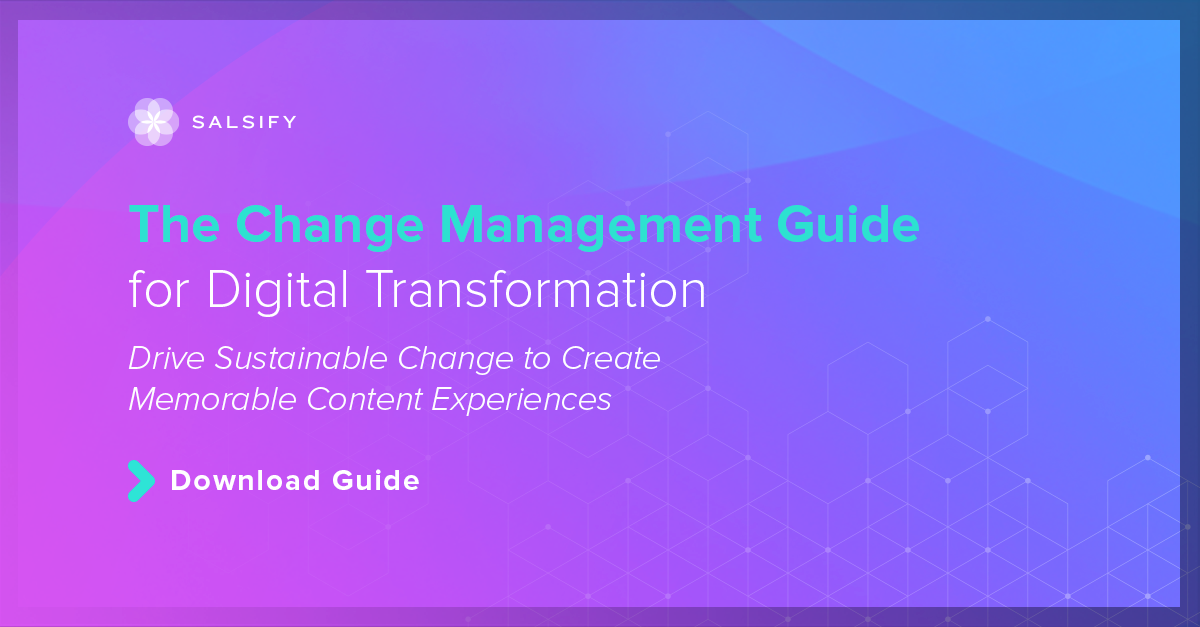

The Change Management Guide for Digital Transformation in Commerce
Ready to start your digital transformation journey? Download our change management guide for more tips on how to effectively transform your retail business.
DOWNLOAD GUIDEPIM
Manage all product content in one central system of record.
Syndication
Easily syndicate product content to every consumer touch point.
Enhanced Content
Enrich product pages with below-the-fold content and rich media.
GDSN Data Pool
Synchronize standard supply chain, marketing, and ecommerce attributes globally.
Grocery Accelerator
Leverage the first-ever category-wide PXM accelerator in the grocery industry.
Digital Shelf Analytics
Continuously optimize your organization’s product content syndication.
Catalog Sites
Share secure, on-brand, and always up-to-date digital product catalogs.
Automation and AI
Automate business processes and enhance Salsify workflows with AI.
PXM Platform, Integrations, and APIs
Integrate the PXM platform with the rest of your enterprise systems architecture.
Supplier Onboarding
Accelerate supplier onboarding while ensuring your schema requirements are met.
Product Listing
Sell products faster with Product Listing.
Content Enrichment
Increase online conversions with Content Enrichment.
Automation
Save time and increase operational efficiency with retail automation.
SXM Platform, Integrations, and APIs
Integrate the SXM platform with the rest of your enterprise systems architecture.
Syndication Network
Automate how you exchange product content data to the digital shelf.
Enhanced Content Network
Turn product pages into product experiences with Enhanced Content.
Commerce Platform Integrations
Create winning product experiences everywhere shoppers are, including on owned sites.
GDSN Data Pool
Synchronize standard supply chain, marketing, and ecommerce attributes globally.
Open Catalog
Connect to the digital shelf faster with an open, standardized, and free product catalog.
Resources
Resource Library
Explore our ecommerce resources to get everything you need to win on the digital shelf.
Blog
Read our blog to get actionable insights for navigating changing markets and industry demands.
Webinars
Watch our on-demand ecommerce webinars to gain expert advice and tips from our community of industry leaders.
Knowledge Base
Investigate our knowledge base to build your Salsify skills and understanding.
Product Updates
Explore the latest news and updates for Salsify products.
API
Examine our comprehensive API and webhook guides to start working with Salsify quickly.

Download our report for emerging consumer trends with direct insights from shoppers that will help you thrive on the digital shelf.

Technology has created a cultural shift in how consumers shop. Consumers increasingly expect retailers to be omnichannel so they can have a seamless shopping experience regardless of whether they’re in a store or online.
This means that even if you’ve already undergone one digital transformation for omnichannel processes, the realities of today’s retail environment demand another.
Meeting these demands means implementing digital technologies that make it easy for consumers to switch between channels without interrupting their shopping journey. It requires a digital transformation designed specifically for omnichannel commerce.
Modern consumers are harder to please and have more digital demands. In the words of McKinsey & Company, today’s consumers are “more connected, less loyal, more informed, and definitively channel agnostic.”
Another McKinsey & Company report found that across all retail categories, 60% to 70% of consumers research and purchase both online and in-store. The International Institute for Management Development (IMD) estimates that retailers who don’t offer omnichannel capabilities miss out on 10% to 30% of sales.
Though the demand for omnichannel experiences is clear, few retailers can meet them. Digital transformation insights firm Incisiv reports that while the majority of retail leaders expect the complexity of their digital operations to increase over the next year, less than half believe they have the technological capabilities necessary to meet them.
In this environment, embracing the next wave of digital transformation is imperative. But how do you begin the process?
Focus first on the technological processes you should transform. The exact processes you digitize or modernize will depend on your unique needs and your consumers’ unique preferences.
Ask yourself the following questions to decide what digital capabilities to focus on:
You may want to conduct customer surveys or other forms of analysis to get a clear picture of where you stand and what shape your omnichannel digital strategy should take.
To hone in on the exact technologies to introduce or upgrade, consider your capabilities in the following broad categories.
If you haven’t yet set up a platform for selling online, that should be your number one priority. If you have, ask yourself if anything about it could be improved. Do you have a product experience management (PXM) solution to manage product information and data?
Ask yourself the following questions to decide if a PXM solution is right for you.
The rise of omnichannel commerce means practices like buy online, pick up in store (BOPIS), buy online, return in store (BORIS), and browsing online before buying from a store and vice versa are second nature to most modern shoppers.
If your sales or inventory processes aren’t yet flexible enough to handle these trends, that’s a great place to start your omnichannel digital transformation.
Fully omnichannel retail requires knowing exactly what’s in your inventory at all times. Upgrading your inventory management software, product catalog, and other back-office technologies is essential to an omnichannel digital transformation that succeeds in the long run.
According to Omnisend, omnichannel consumer engagement campaigns were 429% more likely to result in conversions than single-channel campaigns. Making customer engagement a focus of your omnichannel digital strategy is a great way to nurture more loyal shoppers.
A digital transformation may seem daunting at first, but it can easily be broken down into manageable steps. Here’s a high-level overview of how to implement a successful omnichannel digital strategy.
The ultimate success of any large-scale project depends on having clear goals. Work with your team to determine the specific goals you want to achieve with your digital transformation. Then, list the milestones that will need to be hit to meet those goals. This information will keep you focused on the long road ahead.
There can be resistance to change at first, but you and your leadership all want the same thing: to innovate in a way that satisfies your consumers. You can gain stakeholder support by demonstrating how a digital transformation will achieve this.
Gathering data from consumer outreach and other sources can illustrate the importance of what you’re trying to accomplish. Another potential strategy is to complete a small project related to your overall goals that will give you a quick win, demonstrating how a digital transformation will benefit the business.
You already have your overarching goals and a few milestones. At this point, it’s time to drill down into the specifics of how you’ll reach them.
Think about who will be working on each phase of the project, what they will need to do, and who they’ll need to collaborate with to do it. Get input from all the departments that will be involved so you understand the realities of how they’ll work together.
It may take some time to hammer out all the details, but starting with a clear plan makes the journey faster in the long run.
When you first set your goals, you most likely determined the broad types of technologies you want to implement. Now it’s time to assess specific vendors to select the exact solutions to invest in.
Prioritize vendors who allow free demos and trials so you can see exactly how a solution would be used. Letting everyone who may use that solution try it out can help you select something that will be good for the whole business.
This step will make up the bulk of your digital transformation journey. It’s best to work on implementing one new solution at a time to avoid overwhelm. As you go, assess the success of each implementation and tweak your plans if necessary.
When a new technology is implemented, measure it against your original goals. Is it accomplishing what you wanted?
A digital transformation is not a static project, but one that’s constantly evolving as new technologies and new retail trends arise. Carefully evaluating your success at the end of one project will help you determine how to move forward.
Retail is changing, and retailers need to change with it to survive. For many, a digital transformation is needed to keep up with growing consumer demands.
While the idea of a digital transformation likely seems daunting, it’s perfectly doable with a clear process and some careful planning.

Ready to start your digital transformation journey? Download our change management guide for more tips on how to effectively transform your retail business.
DOWNLOAD GUIDENicole D’Angelo (she/her) is a freelance writer, editor, and content marketer with over eight years of experience creating content for various industries. Previously, she managed content production for business-to-business (B2B) and business-to-consumer (B2C) brands, including Fortune 500 companies.
Standing out on the digital shelf starts with access to the latest industry content. Subscribe to Below the Fold, our monthly content newsletter, and join other commerce leaders.